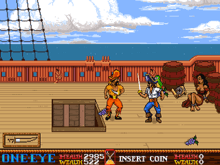Skull & Crossbones
Skull & Crossbones is a two-player video game developed by Atari Games and released in arcades in 1987.
| Skull & Crossbones | |
|---|---|
 | |
| Developer(s) | Atari Games (arcade) Tengen (C64, NES) |
| Publisher(s) | Atari Games (arcade) Domark Tengen (NES) |
| Composer(s) | Hal Canon Don Diekneite Brad Fuller Byron Sheppard |
| Platform(s) | Arcade, Amiga, Amstrad CPC, Atari ST, Commodore 64, MS-DOS, NES, ZX Spectrum |
| Release |
|
| Genre(s) | Beat 'em up |
| Mode(s) | Single-player, two-player |
Gameplay

The game's player characters are One-Eye (player one) and Red Dog (player two), pirates on a venture to find a wizard who kidnapped their princess. In order to rescue their princess, they must collect weapons and booty. The booty is traded for weapons at the end of each level. Which weapons the player receives and how much of each weapon is dependent on what types and how much of each type of booty the player collected. Collecting weapons and booty is absolutely necessary in this game, as your default punch attack is not very powerful and ultimately ineffective. There are several different types of weapons and booty to collect in each level, though not all weapon types appear in every level. The three major weapon types, which appear in most levels are; a cutlass, this is the weakest of the three and only has a slightly farther range than the punch. However, you will not waste a cutlass if it does not hit an enemy. A knife, the mid-level weapon, similar to the knife weapon in Castlevania. The player throws this weapon in a straight line in front of them. Lastly is a flintlock pistol, the most powerful of the three. This weapon fires a musket ball straight in front of the player. To complete each level, the player must defeat 15 enemies, and a level boss. Skull & Crossbones has seven game levels. In some ports of the game, the first six levels may be played in any sequence: One-Eye's Ship, Spanish Castle, Pirate's Ship #1, Ninja Camp, Pirate's Ship #2, Beach Cave, and Pirate's Ship #3. Once these levels are complete, the players go to the final level, the Wizard's Lair.
In the arcade version the players are also given three opportunities to change the difficulty of the game, at the end of One-Eye's Ship level and after the first two Pirate's Ship levels, and have a chance to get an opportunity item in the Castle, Ninja Lair, and Beach Cave. However the levels are forcibly played in the written sequence above. In two player, there are a few specific changes to how the game plays. Players must duel at the end of the level to see which gets the invulnerability item in the levels that have them (The non Pirate Ship levels)
Each Quarter adds 50 health points to whichever player the coin was added for. Each level has a timelimit that can be raised by finding hourglasses off killed enemies, but running out of time only results in slowly losing life and can be counteracted by putting in additional quarters.
Each of the two player pirates behave the same and face either left or right but can turn with the appropriate button. The sword button can be pressed to block and the move stick can be used in addition to throw various attacks, thrusts and stabs. Red X's appeared often denoting jumps and cranks, and white crosses can be dug up with the sword button to find various treasures. A parrot belonging to the pirate constantly flies with the players and recites roughly twelve different lines nonstop. The parrots only appear in the arcade version.
Each of the three pirate ship levels has a Pirate Captain boss at the end of the level and a woman referred to the game as a wench who seems to provide no game benefits, while the other three levels have an Executioner(Heavy Hitter), Monk(Fast Attacker), and Medusa(Turret) boss for their respective stages. The Medusa's attacks can be avoided altogether by facing away and using back-stabs (if the players have chosen the easiest difficulty thus far, an onscreen hint advises them not to look at Medusa.) In the Wizards Lair, these bosses are encountered again in order and the player who grabbed the invulnerability item on their respective stages immediately regains the use of that item for a duration. The wizard boss at the end will appear on one side of the room and launch Wizard Balls that stun the player and when attacked will teleport to the other side and continue. After several hits the player will behead him and will be given a chance to pick up some last wealth items before the game is proclaimed to be over soon afterwards.
Reception
The One gave the Amiga version of Skull & Crossbones an overall score of 77%, noting it as "a slight deviation from the usual beat 'em up fare, and it gives the genre a couple of unusual twists." The One praises Skull & Crossbones' graphics and music, stating that the graphics "convey the action well enough and, together with a brace of catchy tunes, they help create the perfect pirate atmosphere" and express that the two-player mode adds "a lot more fun, since you've got the added element of fighting over who gets the extra energy and money." The One concludes that "[Skull & Crossbones] isn't the greatest or most polished beat 'em up in existence" but is 'good and entertaining'.[1]
References
- Watsham, Julian (May 1991). "Skull and Crossbones Review". The One. No. 32. emap Images. pp. 74–75.